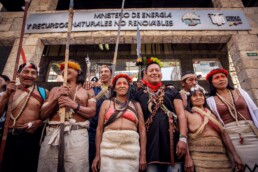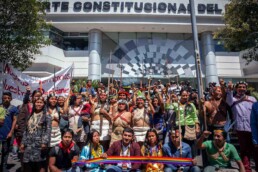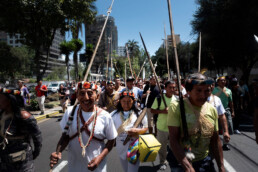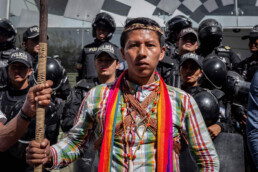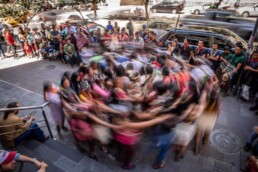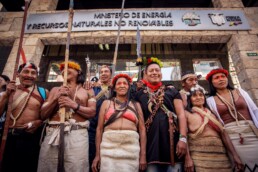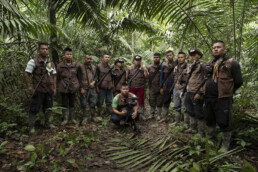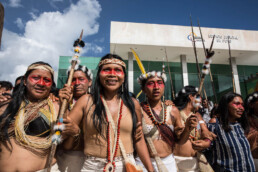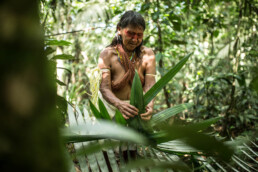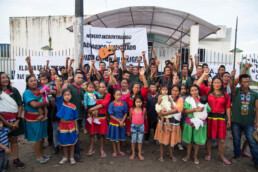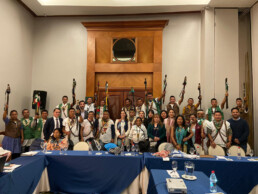Letter from Indigenous Women of the Western Amazon
A Letter From Kofan, Siekopai, Siona, and Waorani women of our indigenous partner organization, Ceibo Alliance. Click here to read the original Spanish letter entitled “We Are Resistance of The Forest, Love & Peace”.
With love and peace, we, women from four indigenous nations of the Western Amazon, are fighting against the threats to our forest.
The Amazon gives life to our planet. And for us, as indigenous peoples, it is our home. Yet every day, the threats grow bigger. Oil companies, loggers, cattle ranchers, and armed groups endanger our lives and destroy our territories, and governments continue to violate our rights. They want to exploit our territories, displace us, and exterminate us. They do not want us to live in peace and harmony. They continue to contaminate our Mother Earth, our rivers, our animals, and our bodies. And as the forest is destroyed, our cultures and our ancestral knowledge are disappearing even faster – and forever.
As women, we were deeply saddened and pained to witness the fires that devastated millions of acres of primary rainforest in Brazil, Bolivia and Paraguay last year, as a result of the invasions of cattle ranchers and large agribusinesses on indigenous lands. Despite the distance between our homes, we know that we are all united in this fight to protect our forest. The Amazon is not divided in parts, it is one whole being. And we know that what happened with the fires could also happen here, if the trees continue to be cut down, and if extractive companies continue to enter our territories. Our forest could dry up and become a desert.
Building the Path Forward
Over the past few years, we have achieved great victories here in the Ecuadorian Amazon, which have strengthened us and given us hope in our fight against extractivism and for the cultural survival of our peoples. At the headwaters of the Aguarico River in the northern Ecuadorian Amazon, the Kofan community of Sinangoe won a landmark victory against gold mining and for the rights of nature. The courts recognized that the government had violated the Kofan’s right to prior consultation and that mining threatened their survival and the rivers. And more recently, Waorani communities from the south-central Ecuadorian Amazon won a historic battle against big oil. Women, grandmothers, and girls were at the forefront of these unprecedented legal victories, alongside men, demanding that the State respect indigenous peoples’ rights and decisions over their territories. And we triumphed!
But we know that the threats to our lives and our territories will not diminish. As women, we are growing stronger. We are standing up for our rights and putting our bodies on the line to defend our families and our territories. We are active in our communities’ land patrols (or “guardias”), climbing tremendous mountains, detecting new threats, confronting invaders, and protecting life. Women defenders are setting a courageous example for our girls and for the generations to come. They bravely take on this work, in addition to all the responsibilities they have as a woman in their community and in the face of ongoing gender discrimination. These women strengthen our fight for equality against a patriarchal system: because this fight includes everyone.
Weaving Our Dreams
We dream of a future where our grandchildren can enjoy the inheritance from their ancestors: a forest in which they can breathe fresh air, run freely, and lead a healthy life. Over the past years, we have been organizing ourselves and creating women’s associations to create economic alternatives to resource extraction for our families and communities, through initiatives such as tailoring, hand crafts, and other products such as chocolate.
We are now embarking on a powerful journey to build our own educational systems, based upon our cultures and ways of life. We believe that an education rooted in our identity and our territory will strengthen our struggle to defend the forest, and allow our grandchildren to grow strong and confident. They’ll be able to speak their own language, and carry on our traditions, our customs and our cosmovisions. They won’t be as vulnerable to discrimination and they’ll be able to interact with the Western world without the need to change their identity.
Women are guardians of the ancestral knowledge of our peoples. Women have always been important because we are the ones who take care of and raise our children. Our grandmothers are pillars for our communities. They have many stories to tell, much advice to offer, and lots of wisdom to share. For this reason, we also aspire to become journalists, photographers and filmmakers. We want all women’s voices to be heard. We want our stories to be told, our ancestral knowledge to be recovered, and our visions to be shared according to our own experiences and our strength as women.
We will continue dreaming to protect our forest. We are the earth, the water, the air. We are the forest itself. And for her, we will continue to fight and unite until the end, with lots of love, and lots of rebellion.
“Nuestra Selva es Nuestra Vida”: Pueblos indígenas de Ecuador Defienden Victorias Históricas Contra el Extractivismo en la Amazonía
Después de un largo recorrido desde la Amazonía, viajando a pie, en canoa y por tierra, cientos de indígenas llegaron a la capital de Ecuador el 13 y 14 de febrero, para movilizarse en apoyo de las comunidades Waorani de Pastaza y A’I Cofán de Sinangoe. Las victorias históricas de ambas nacionalidades contra los intereses petroleros y mineros han inspirado a cientos de personas de las comunidades indígenas de la Amazonía en su resistencia contra el extractivismo.
Llegaron juntos con otras nacionalidades indígenas de la Amazonía Ecuatoriana, incluyendo los Kichwa, Sapara, Shiwiar, Shuar, Siekopai y Siona, que enfrentan violaciones de derechos y otras amenazas similares en sus territorios. Jóvenes y ancianos salieron a las calles de Quito con canciones, bailes tradicionales y organizaron importantes movilizaciones afuera de varias instituciones estatales, para denunciar la complicidad del gobierno en la destrucción de la Amazonía y su incumplimiento de las sentencias judiciales. Los Waorani y A’I Cofán se reunieron con la Corte Constitucional de Ecuador, que seleccionó el caso de A’I Cofán de Sinangoe para generar jurisprudencia nacional. Ambas nacionalidades presentaron sus criterios sobre la importancia de incluir a los pueblos indígenas dentro de cualquier debate y análisis sobre los derechos a la autodeterminación y la consulta previa.
Los Waorani y A’I Cofán saben que hay mucho en juego y que sus victorias presentan oportunidades invaluables para promover la ley y los derechos indígenas no solo en Ecuador, sino en toda la región. Sin embargo, a pesar de sus importantes triunfos contra las petroleras, mineras y el reconocimiento de la importancia de sus casos por parte de la Corte Constitucional del Ecuador y de las Naciones Unidas, la agenda extractivista del gobierno continúa sin restricción. Anuncios recientes revelan planes para expandir las concesiones petroleras y mineras en la Amazonía para pagar la deuda del país con China, poniendo en peligro los bosques, territorios indígenas y el clima de nuestro planeta.
En 2018 y 2019, los A’I Cofán y Waorani ganaron batallas legales sin precedentes contra el gobierno Ecuatoriano, protegiendo cientos de miles de hectáreas de bosques primarios de mega biodiversidad y estableciendo valiosos precedentes legales para los derechos indígenas en el país y la región amazónica. En los próximos meses, los Waorani y A’I Cofán continuarán aumentando la presión para asegurar que el gobierno ecuatoriano respete los derechos y territorios indígenas.
“Somos la voz de la selva. Exigimos que el gobierno nos escuche y nos respete. Seguimos resistiendo. Nuestras sentencias son importantes porque definen nuestro futuro como pueblos indígenas; son una herramienta importante para garantizar nuestros derechos y nuestra supervivencia física y cultural en nuestros territorios”
El joven líder A’I Cofán, Alex Lucitante, transmite un poderoso mensaje fuera de la Corte Constitucional de Ecuador durante una rueda de prensa. En noviembre de 2019, la Corte Constitucional seleccionó el caso A’I Cofán Sinangoe a fin de convertir su victoria en jurisprudencia nacional para los pueblos indígenas de todo el país.
“Nuestro territorio es nuestra casa y no permitiremos que el Estado destruya nuestros territorios y nuestra existencia. Nuestra lucha no es solo para nosotros como pueblo waorani. Estamos unidos en la misma lucha con nuestros hermanos y hermanas de otras nacionalidades, como los Shuar, los Shiwiar y los Sapara. Estamos luchando por nuestra vida y por las generaciones futuras. El gobierno debe escucharnos y respetar nuestras decisiones. ¡Seguiremos resistiendo y uniéndonos!”
La líder Waorani, Nemonte Nenquimo, quien fue la principal demandante en el caso de las comunidades Waorani de Pastaza que ganaron una victoria histórica el año pasado y que lograron proteger medio millón de acres de su territorio de la selva de la perforación petrolera, se pronuncia durante una rueda de prensa frente a la Corte Constitucional del Ecuador.
Una delegación de representantes Waorani y A'I Cofán participan en una reunión oficial con varios jueces de la Corte Constitucional del Ecuador. Comunidades Waorani y A'I Cofán solicitaron que la Corte escuche el testimonio de los pueblos indígenas antes de pronunciarse sobre los derechos indígenas fundamentales
La abogada de Amazon Frontlines, María Espinosa, habla durante una rueda de prensa frente a la Corte Constitucional del Ecuador: “A estas comunidades les han violado derechos y se afectó sus vidas. Hemos venido a decir a la Corte Constitucional que tiene un oportunidad histórica en sus manos. No solo por el hecho de poder acumular estas dos sentencias, si no por pronunciarse de fondo sobre un derecho que define la protección por la extinción de pueblos indígenas”
“Como autoridades tradicionales hemos venido a exigir que respeten nuestro derecho a la vida, nuestros territorios no están en venta”
– Omanca Enquiri, Pekinani (líder tradicional). Las comunidades Waorani de Pastaza esperan que su caso sea seleccionado, junto con el caso A’I Cofán de Sinangoe, para garantizar que los derechos de los pueblos indígenas a la consulta previa y la libre determinación estén garantizados de acuerdo con la Constitución ecuatoriana y las leyes internacionales.
“No es la primera vez que venimos. Nuestras sentencias no se han cumplido. Nuestra vida está en riesgo. En nuestra comunidad, no se ha visto a funcionarios del Ministerio de Ambiente caminando en nuestro territorio, mientras la minería se hace presente sin el control del Estado y sigue amenazando nuestra existencia”
Presidente de la comunidad A’I Cofán de Sinangoe, Edison Lucitante, habla con el viceministro de Medio Ambiente de Ecuador en su sede de Quito.
Miembros de comunidades Waorani y A'I Cofán bailan después de entregar un mensaje unido y una advertencia al Ministerio de Energía y Recursos No Renovables de Ecuador en la ciudad de Quito: “Nunca permitiremos que las industrias extractivistas ingresen a nuestros territorios ancestrales. El Estado debe respetar nuestras decisiones sobre nuestros territorios”
“Our Forest Is Our Life": Indigenous Peoples from Ecuadorian Amazon Defend Historic Victories For Indigenous Rights & Amazon Protection
After a long journey from the Amazon traveling by foot, by canoe and by road, hundreds of indigenous peoples arrived in Ecuador’s capital city last week to mobilize in support of the Waorani and Kofan nations, whose historic victories against oil and mining interests have inspired hundreds of indigenous communities across the Amazon in their resistance against extractivism.
United with other indigenous nations from the Ecuadorian Amazon including the Kichwa, Sapara, Shiwiar, Shuar, Siekopai, and Siona, who face similar rights violations and threats in their territories, indigenous youth and elders took to the streets of Quito in song and dance and staged powerful mobilizations outside several State institutions to denounce the government’s ongoing complicity in Amazon destruction and its failure to comply with their court rulings. The Waorani and Kofan notably met with Ecuador’s Supreme Court, which has accepted the Kofan of Sinangoe’s case for review – an important feat for indigenous peoples in Ecuador, which could also mark the country’s first ever Supreme Court ruling on prior consultation and the right to self-determination as applied to indigenous peoples.
The Waorani and Kofan know the stakes are high, and that their victories present invaluable opportunities to advance the law and indigenous rights not only in Ecuador, but across the region. Yet despite their important triumphs against big oil and mining and the recognition of the importance of their cases by Ecuador’s Supreme Court and the United Nations, the government’s extractive agenda continues full throttle. Recent announcements reveal plans to expand oil and mining concessions in the Amazon in order to repay the country’s crushing debt to China, imperiling our world’s most important forest, indigenous territories, and our planet’s climate.
In 2018 and 2019, the Kofan and Waorani won unprecedented legal battles against the Ecuadorian government, protecting hundreds of thousands of pristine megabiodiverse rainforest, and setting invaluable legal precedents for indigenous rights in the country and the Amazon region. In the months ahead, the Waorani and Kofan will continue to ramp up the pressure to ensure that the Ecuadorian government respects indigenous rights and territories.
“We are the voice of the forest. We demand that the government listen to us and respect us. We continue to resist. Our legal victories are important because they define our future as indigenous peoples; they are an important tool to guarantee our rights and our physical and cultural survival in our territories”
Young Kofan leader Alex Lucitante delivers a powerful message outside Ecuador’s Supreme Court during a press conference. The Ecuadorian Supreme Court, in November of 2019, selected the Kofan community of Sinangoe’s ruling for review in order to turn their victory into national jurisprudence for indigenous peoples across the country.
“Our territory is our home and we will not allow the State to destroy our territories and our existence. Our fight is not just for us as Waorani people. We are united in the same struggle with our brothers and sisters from other indigenous nations, such as the Shuar, the Schiwiar, the Sapara. We are fighting for our life and for the future generations. The government must listen to us and respect our decisions. We will continue to resist and unite!”
Waorani leader Nemonte Nenquimo, who was lead plaintiff for her people’s legal victory last year protecting half a million acres of their rainforest territory from oil drilling, speaks out during a press conference outside Ecuador’s Supreme Court.
Amazon Frontlines Lawyer Maria Espinoza speaks out during a press conference outside Ecuador’s Supreme Court: “These communities’ rights have been violated and their lives have been affected. The Supreme Court now has a historic opportunity in its hands, not only to review both Waorani and Kofan cases, but also to make a clear declaration on the right to free, prior and informed consent, a right which protects indigenous peoples from extinction”
“As Waorani elders, we have come to demand respect for our right to life. Our territories are not for sale”
– Omanca Enquiri, Waorani leader and elder (also known as a “Pekinani” in the Waorani people’s language). The Waorani people hope that their case will be selected, alongside the Kofan people’s case, to ensure that indigenous people’s rights to prior consultation and self-determination are guaranteed in accordance with the Ecuadorian Constitution and international law.
“This is not the first time we have come here. Our court ruling is not being complied with. Our lives are at risk. The Ministry of the Environment is not taking actions to protect or monitor our territory and mining continues to threaten our existence”
Kofan leader and President of the Sinangoe community, Edison Lucitante, speaks out to Ecuador’s Vice-Minister of the Environment inside their headquarters in Quito.
PUBLIC STATEMENT OF WARNING TO OIL COMPANY GEOPARK
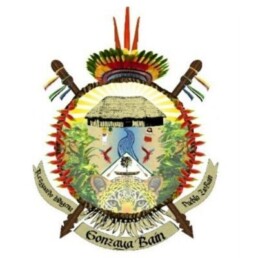
The Siona people of the Buenavista Reserve warn the multinational company GeoPark, possible buyer of Amerisur Resources, that we will not allow extractive operations in our territory and by acquiring Amerisur it also acquires its liabilities for human and indigenous rights violations against our people and our territory
In light of recent publications in the press revealing the bet by multinational oil and gas company GeoPark to position itself as a leader of hydrocarbon operations in Colombia, specifically the investment of $311 million towards the purchase of the British company Amerisur Resources in order to increase the production of crude oil barrels in the oil blocks within the Putumayo River watershed, we WARN GeoPark and the world, that the business acquisition includes the obligations and liabilities for serious violations of human rights, socio-environmental damages and other impacts pending restitution for the Siona people that were caused by Amerisur.
It bears repeating that Amerisur stands in opposition within a judicial process to restore territorial rights to the Buenavista Reserve within the framework transitional justices to redress victims of the armed conflict that continues in Colombia. The manner in which Amerisur has tried to take our natural resources through illegal and rigged action, systematically lying to our community and using trickery in attempts to validate a prior consultation process over oil block PUT-12 that ended WITHOUT AGREEMENT, has also been extensively documented.
Additionally, by virtue of a court-ordered injunction in 2018 within the land restitution process, 56,529 hectares of our ancestral and reserved territory are currently protected with an express prohibition against any exploration or exploitation of natural resources. Since 2009, the Siona people have been recognized by the Constitutional Court, the highest court of Colombia, as being in imminent risk of physical and cultural extinction for the direct actions of the armed-conflict, but also for undue pressures coming from what are considered underlying factors of the armed-conflict, such as the interests of extractive projects over indigenous territories.
The situation of urgency, along with the disrespect of the autonomy and self-determination of the Siona People of Buenavista Reserve, motivated the Interamerican Commission on Human Rights, in its decision MC-395-18, to grant precautionary protection measures that obligate the Colombian State to agree to culturally adequate protection road-maps that safeguard the life, liberty and integrity of our indigenous leaders, our communities, and our territory.
We insist that, in virtue of our right to indigenous law, backed by our Origen Law and ratified in our Resolutions 001, 002, 003 and 004 from 2016-2017 by our own traditional and political authorities, the Siona People of the Buenavista Reserve resoundingly reject any and all activities related to the exploration or exploitation of oil within our ancestral and guarded territories.
The expansion of extractive operations in the Department of Putumayo, with all of its implications and actors, has caused serious violations to our human and indigenous rights and remains a grave threat to the physical and cultural survival of our people. By not halting its intervention in our territory, Amerisur or GeoPark can be responsible for multiple new violations as the live and survival of the Siona People of Buenavista Reserve depends on the conservation and protection of our territory. We warn GeoPark that in buying all of Amerisur’s business interests you are also acquiring all of its obligations and liabilities for violations of human rights caused by Amerisur and the increased risk of extinction faced by our people. As the same time, we REPEAT our determination to maintain our territory free of extractive activities due to the grave risks due to the emission of toxic wastes, the impacts on our spiritual practices, and the community conflicts generated since the commencement of operations by Amerisur, including the exacerbation of conflicts generated by the presence of armed-actors, regular or irregular, in our territory.
We resist, we fight, we remain firm in the defense of our lives, our millenary territory, and the preservation of the ancestral wisdom of the Siona people.
We are a great people in heart and mind.
SANDRO PIAGUAJE
Governor
Siona Reserve of Buenavista
gobernadorbuenavista@gmail.com
DENUNCIA PUBLICA: ADVERTENCIA A EMPRESA PETROLERA GEOPARK

El pueblo Siona del Resguardo Buenavista advierte a la empresa multinacional GeoPark, posible compradora de Amerisur Resources, que no permitiremos actividades extractivas en nuestro territorio y al adquirir los activos de Amerisur adquiere también sus responsabilidades por la violación de derechos humanos y colectivos contra nuestro pueblo y nuestro territorio.
Teniendo en consideración recientes publicaciones en prensa que dan cuenta de la apuesta de la multinacional Geopark para posicionarse como líder de operaciones hidrocarburíferas en Colombia, específicamente con una inversión de $311 millones de USD orientada a la compra de Amerisur Resources que tiene como objetivo aumentar la producción de barriles de crudo en los bloques concesionados en la cuenca del río Putumayo, queremos ADVERTIR a Geopark y al mundo, que el negocio societario incluye las obligaciones y responsabilidades por graves violaciones a los derechos humanos, pasivos socio-ambientales y demás afectaciones pendientes de reparación ocasionadas por Amerisur al Pueblo Siona.
Se reitera que la Empresa Amerisur es OPOSITORA dentro de un proceso judicial de restitución de derechos territoriales instaurado por el Resguardo Buenavista en el marco de la justicia transicional de atención a las víctimas del conflicto armado interno que se encuentra en curso; que se ha documentado extensamente la modalidad de despojo de nuestros recursos naturales como consecuencia del accionar ilegal y amañado de la petrolera, quien ha mentido sistemáticamente a la comunidad y con engaños pretendió hacer valer una consulta previa sobre el Bloque Put-12 que culminó con una PROTOCOLIZACIÓN SIN ACUERDOS.
Adicionalmente, en virtud de una Medida Cautelar otorgada en el año 2018 dentro del proceso de restitución de tierras, se encuentran protegidas 56.529 Hectáreas de territorio ancestral y resguardado, con una prohibición expresa de adelantar actividades de exploración y/o explotación de recursos naturales que se encuentra en firme. Desde el año 2009 el Pueblo Siona fue reconocido por la Corte Constitucional, máximo Tribunal de protección de derechos fundamentales en Colombia, en riesgo inminente de exterminio físico y cultural por el accionar directo de la guerra, pero también por presiones indebidas de lo que consideró factores subyacentes del conflicto armado, tales como los intereses extractivos y megaproyectos que pretenden ser establecidos en los territorios indígenas.
La urgencia manifiesta, el irrespeto a la autonomía y autodeterminación del Pueblo Siona del Resguardo Buenavista, motivaron a que la Comisión Interamericana de Derechos Humanos mediante la decisión MC-395-18 otorgara medidas cautelares de protección obligando al Estado Colombiano a concertar rutas de protección culturalmente adecuadas para salvaguardar la vida, libertad e integridad de las autoridades indígenas, las comunidades y su territorio.
Insistimos que, en virtud del Derecho propio, amparados en nuestra ley de origen y ratificados en las Resoluciones 001, 002, 003 y 004 emitidas en 2016 y 2017 por nuestras autoridades tradicionales y políticas, el Pueblo Siona del Resguardo Buenavista rechaza de manera contundente la realización de actividades de exploración y explotación de petróleo dentro de nuestro territorio ancestral y resguardado.
Dado que la expansión de la actividad extractiva en el Departamento del Putumayo, con todas sus implicaciones y actores, ha sido causante de graves violaciones a nuestros derechos humanos y colectivos y supone una grave amenaza para la pervivencia física y cultural de nuestro pueblo; y, que, de no frenar su intervención en nuestro territorio, puede seguir siendo responsable de otras múltiples violaciones y ya que la vida y pervivencia del Pueblo ZioBain (Siona) del Resguardo de Buenavista depende de la conservación y protección a nuestro territorio advertimos a GeoPark que al comprar todos los activos de la empresa AMERISUR también esta adquiriendo todas las obligaciones por las violaciones a derechos humanos que la empresa Británica ha ocasionado y que han incrementado el riesgo de exterminio que enfrenta nuestro Pueblo, así mismo REITERAMOS nuestra determinación de mantener nuestro territorio libre de actividades extractivas por el grave riesgo que representan por la emisión de vertidos tóxicos, las afectaciones a nuestras practicas espirituales y los conflictos comunitarios generados desde el inicio de operaciones de Amerisur que incluyen la exacerbación de conflictos generados por la presencia de actores armados regulares e irregulares en nuestro territorio.
Resistimos, Luchamos, Permaneceremos firmes en la defensa de la vida, de nuestro territorio milenario, en la preservación de la sabiduría ancestral del Pueblo ZioBain.
Somos un pueblo grande de corazón y pensamiento.
SANDRO PIAGUAJE
Gobernador
Resguardo Siona Buenavista
gobernadorbuenavista@gmail.com
Pëëkë’ya (Lagartococha): Journey To Our Spiritual Origin
In August of this year, over 50 women, men, elders and youth from the Siekopai (Secoya) nation of the Ecuadorian Amazon embarked on a historic five-day canoe journey and paddled 160 kilometers (100 miles) to the sacred lagoons of Ñakomasira, the heartland of their ancestral territory – Lagartococha – on the border between Peru and Ecuador.
In the following story, indigenous photographers Jimmy Piaguaje and Ribaldo Piaguaje from the Siekopai nation share moments and memories from their incredible journey within this mega-diverse labyrinth of blackwater lagoons, flooded forests and rolling hills. Their photos follow their trip, as they fished along the river, slept on the beaches, visited historic places, shared ceremony with their elders, and learned about the history and ancestral lands of their people.
Their journey marks an important step forward as part of the Siekopai’s struggle to reclaim sacred lands they were forcibly displaced from during a border-war in the 1940s between Peru and Ecuador, and the Siekopai’s attempts to return have all been derailed by a lack of formal land rights within what is now a national park. As they fight for Lagartococha, an area so critical to their physical and cultural livelihood that without it their existence is imminently threatened, the Siekopai hope to pave the way for other indigenous nations to do the same.
The Lagarto River, named for the abundance of alligators within it, slithers and weaves through black water lagoons that reflect the forest, like a mirror hidden deep in the Amazon on the border between what are now the territories of Ecuador and Peru.
This territory is the spiritual center of our ancestors, it is the cradle of our yage (ayahuasca) drinkers and our connection with the aquatic world. Lagartococha is the spiritual origin of our people – the Siekopai, the Multi-Colored People.
From the time war broke out in 1941 between Peru and Ecuador, our people were forcibly displaced, and many of our families were separated. We were uprooted from our ancestral territory. Today, in Ecuador, we live in a small territory surrounded by oil companies, roads and the African palm industry, nearly 200 kilometers upriver from where our grandparents were born and raised.
RECLAIMING OUR SACRED LANDS
But we, Siekopai, have always kept the memory of Lagartococha alive. It is here that the bones of our ancestors rest. Our elders still recount the stories of our ancestors who navigated along the waters of Lagartococha. This is why we are fighting for the Ecuadorian government to recognize our right to our ancestral territory. For many generations, our people have been dreaming and fighting to recover their ancestral territory.
And so we began this journey in order to make our struggle visible to others. Our elders shared with us their stories, their legends and their knowledge about our ancestral territory, and in this way, the youth of our nation reconnected to the territory of our ancestors.
Each day, our elders’ voices would wake us up in the early hours of the morning before dawn. They summoned us to drink yoko, a beverage made from the scrapings of a vine. Drinking yoko gave us energy, courage and strength, while we listened to the stories and advice of our elders for the days ahead.
Lagartococha is a magical place. It is full of life. The forest is thick and it is home to a great diversity of animals. For us, Lagartococha is not only a place of great spiritual importance, it also provides us with our subsistence. The forest gives us fruits and many medicinal plants, and the river abounds with fish to feed our families.
“Pëëkë’ya – Lagartococha
is our territory, our blood, our birthplace, the foundation of our cosmovision. The bones of our ancestors rest there. Since 2017, we have demanded that the Ecuadorian government gives us ownership over these lands. We have legal, geographical and anthropological evidence demonstrating that this 100,000 acre territory is ours. Today, we are only 600 Secoya left in Ecuador and at risk of disappearing culturally and physically.”
– Justino Piaguaje, Siekopai leader and President of the Siekopai nation of Ecuador
For many children and young people, this journey marked their first visit to Lagartococha. It was a very special experience, and we felt a lot of happiness when some of our families were reunited with their relatives on the Peruvian side of our ancestral territory.
After five days of sharing stories and visiting ancient village sites, burial grounds, and sites of ceremonial lodges while listening to the experiences of our parents and elders, we arrived to the legendary and sacred Ñakomasira (Wounded Eye) lagoon, which is home to several beings and spirits of the aquatic world.
Our canoe journey to Lagartococha will be forever engraved in the memory of our nation’s young generations. These are important steps to recover our memory as a people, and to unite ourselves in order to ensure that the legacy of our ancestors can continue to be passed down from generation to generation. We want to maintain our spiritual connection with the place of our origins. As young people, we will continue this struggle to recover our roots, so that the future generations do not forget and understand what it means to be truly Siekopai.
Ratificación del triunfo Waorani: Corte Constitucional ecuatoriana inadmite acción interpuesta por Ministerio y Procuraduría

28 de noviembre de 2019 - Meses después de una victoria histórica contra el gobierno ecuatoriano, comunidades waorani de Pastaza han obtenido un nuevo triunfo, que les ratifica los fallos sobre su caso y protege de la perforación petrolera a 180.000 hectáreas de selva amazónica. El 27 de noviembre de 2019, la Corte Constitucional ecuatoriana (CC) inadmitió la acción extraordinaria de protección interpuesta en agosto de este año por el Ministerio de Energía y Recursos Naturales No Renovables y la Procuraduría General del Estado.
Este logro es relevante, porque se constituye en la última posibilidad del Estado para tratar de impedir, a través de una acción constitucional, la ejecución de las sentencias del 26 de abril y del 11 de julio de 2019, lo cual, en consecuencia, reconoce el derecho de los Waorani a ejercer autoridad en su territorio colectivo y ancestral. Los referidos dictámenes ratificaron que 16 comunidades Waorani de Pastaza fueron vulneradas en su derecho a la autodeterminación y a la consulta previa, libre e informada, en el marco de la décimo primera ronda petrolera Suroriente dentro del bloque 22, ubicado en dicha provincia.
Nemonte Nenquimo, Coordinadora General del Consejo de Coordinación de la Nacionalidad Waorani del Ecuador – Pastaza (CONCONAWEP) y demandante, manifiesta que, al ratificar las referidas sentencias, este fallo da cuenta de que la protección de la vida de los Pueblos Indígenas, de la selva amazónica y del planeta se logra con trabajo conjunto. Asimismo, enfatiza que:
“Seguimos demostrado al mundo que la vida es más importante que el petróleo. Seguimos firmes en nuestra lucha para que el gobierno cumpla esta sentencia. Nuestra lucha es mantener el territorio Waorani en Pastaza libre de petróleo para siempre. Tenemos el derecho de decidir, y esa es nuestra decisión”.
Por su parte, tanto el Presidente de la Confederación de Nacionalidades Indígenas del Ecuador (CONAIE), Jaime Vargas, como su par en la Confederación de Nacionalidades Indígenas de la Amazonía Ecuatoriana (CONFENIAE), en respaldo a la Nacionalidad Waorani, se congratulan con la sentencia. Jaime Vargas indica que:
“[…] ratifica que la verdad siempre estuvo del lado del pueblo Waorani y de las nacionalidades. Todas aquellas sentencias ganadas en los tribunales a base de la lucha histórica deben cumplirse y ejecutarse, tal es el caso de esta sentencia y las de Sinangoe, Piatua, Sarayaku y Río Blanco”
Marlon Vargas añade que este triunfo es “la ratificación de la legítima lucha del pueblo Waorani. Es una nueva victoria para todas las nacionalidades amazónicas”.
Entre las motivaciones sobre las supuestas vulneraciones que el Ministerio de Energía y Recursos Naturales No Renovables y la Procuraduría General del Estado alegaron ante la CC constan los derechos constitucionales de “la seguridad jurídica, la tutela judicial efectiva y al debido proceso en las garantías a la motivación y a ser escuchado en el momento oportuno”. No obstante, el órgano de control constitucional indicó que los accionantes intentaron usar una acción extraordinaria como “nueva instancia”. De igual forma, que las instituciones estatales:
“no construyeron un argumento claro y secuencial que explique cómo sus derechos presuntamente vulnerados se relacionan con una omisión o acción de las autoridades judiciales”, e intentaron usar una acción extraordinaria como “una nueva instancia”.
Adicionalmente, la Corte Provincial de Pastaza ordenó el envío de la sentencia en el caso Waorani a la CC para su revisión y selección en la generación de jurisprudencia nacional. En ese sentido, instamos al ente constitucional a elegir este caso, pues, en cumplimiento de su misión de garantizar la vigencia y supremacía de la Constitución, tiene la oportunidad y la responsabilidad de establecer criterios claros y obligatorios para el Gobierno, asegurando el respeto y la protección a los derechos de los Pueblos Indígenas y de la naturaleza.
Sabemos que la Corte Constitucional ya seleccionó la sentencia a favor de la comunidad A’I Cofán de Sinangoe para generar jurisprudencia nacional, por su gravedad y trascendencia nacional. Por ello, es urgente que nuestra sentencia, al ser también un proceso de vulneración al derecho colectivo de la consulta previa, libre e informada, sea también elegida, y, así, se establezcan principios y estándares diferenciados, para obtener el consentimiento previo de los pueblos indígenas. Que esto ocurra sería un aporte fundamental para que todos los Pueblos Indígenas fortalezcan sus estrategias de resistencia, amparados también en normativas que reconozcan la defensa territorial y ratifiquen el respeto a la autodeterminación.
En relación a lo anterior, Lina María Espinosa, Defensora de Derechos Humanos y abogada de la nacionalidad Waorani, asegura:
“[con el fallo] se toman en cuenta consideraciones seccionales sobre la Nacionalidad Waorani por el hecho de ser un pueblo de reciente contacto. Pero, fundamentalmente, se hace un vínculo entre consulta, autodeterminación y consentimiento, con lo cual es oportuno que la Corte Constitucional tome esta sentencia de manera paralela a la de Sinangoe; realice una análisis de fondo de lo que implican los derechos a la consulta previa, al consentimiento y a la autodeterminación; y, con ello, se proteja a los pueblos y a sus territorios”.
Finalmente, insistimos en la necesidad de que el Estado de cumplimiento a la sentencia que emitió la Corte Provincial de Pastaza, en julio de 2019, pues, en la misma, se determinó como medida de reparación que el Ministerio de Energía y Recursos No Renovables capacite:
“de manera suficiente a sus funcionarios respecto de los derechos de autodeterminación y consulta previa, a fin de que sean implementados en todos los procesos de hidrocarburificos [sic], en donde se encuentren involucrados comunidades, pueblos y nacionalidades indígenas”.
Llama la atención que esta Cartera de Estado como cumplimiento a la sentencia, ha proporcionado documentos en los cuales demuestran que han intentado, mediante los organismos propios del Estado, autocapacitarse en esta materia, sin generar diálogos con los actores de las comunidades y nacionalidades indígenas. Con esto, por un lado, se evidencia una pretensión de las autoridades estatales de ser conocedores absolutos del tema y, por otro, demuestra la negativa de reconocer la capacidad y la urgencia de la participación de los Pueblos Indígenas en la construcción de procesos interculturalmente pertinentes, en un país plurinacional como el Ecuador.
Además, esto apunta no solamente al incumplimiento de la sentencia tal como fue dictada, sino a la sistemática instrumentalización de la consulta previa, libre e informada por parte de las instituciones obligadas a garantizarla. Recordamos que la Relatora Especial de Pueblos Indígenas de Naciones Unidas, Vicky Tauli Corpuz, en su informe de septiembre de 2019, recomendó al Ecuador el cumplimiento sin demora de las “sentencias […] consonantes con los derechos de los pueblos indígenas internacionalmente reconocidos […]”.
Contactos:
Para obtener más información, entrevistas o solicitudes de fotos/videos, comuníquese con:
Sophie Pinchetti, Comunicadora Amazon Frontlines – sophie@amazonfrontlines.org
Contactos del caso Waorani:
Lina María Espinosa, Abogada de los demandantes – +593 98 633 84 95.
Nemonte Nenquimo, Presidenta CONCONAWEP – +593 97 970 9411.
Oswando Nenquimo, vocero Waorani – +593 99 359 3849.
Caso A’i Cofan Sinangoe fue seleccionado por Corte Constitucional para generar jurisprudencia nacional

15 de noviembre de 2019. Quito, Ecuador – La sentencia histórica de la comunidad Sinangoe, perteneciente a la nacionalidad A’i Cofán, fue selecionada por la Corte Constitucional del Ecuador para desarrollar jurisprudencia nacional ante la vulneración sistemática del derecho a la consulta previa. Los jueces Carmen Corral Ponce, Alí Lozada Prado y Hernán Salgado Pesantes, jueces de la Corte Constitucional del Ecuador, eligieron el caso No. 273-19-J, debido a su gravedad y relevancia o trascendencia nacional. Entre otras cosas, el documento emitido por la CC señala que:
“El asunto presenta gravedad porque la actividad minera, de no ser adecuadamente consultada, informada, planificada y ejecutada, podría provocar afectaciones a los territorios ancestrales, debido a que induciría a un cambio radical en sus formas de vida y amenazaría con causar daño a la naturaleza, al agua, al medio ambiente, a la cultura, al territorio y a la salud”.
Alex Lucitante, vocero de la comunidad, manifiesta que el fallo de la CC es relevante porque permite que los todos los Pueblos Indígenas del Ecuador tengan una “herramienta muy importante para defensa de su territorio en temas mineros”. A decir del lider, cuando la jurisprudencia se desarrolle, la misma obligará al Estado ecuatoriano a desarrollar protocolos culturalmente adecuados para la consulta previa, libre e informada y, en consecuencia, para garantizar los derechos de los Pueblos Indígenas. Asimismo, agrega:
“Esto es un motivo de aplaudir y estar felices de este gran logro, en seguimiento a nuestra victoria para la protección de nuestros territorios ancestrales. La justicia de Ecuador ha demostrado que nosotros como Pueblos Indígenas tenemos el derecho a la autodeterminación y al autogobierno en nuestro territorio. Nosotros seguimos en la lucha”.
El actual dictamen es significativo para todos aquellos pueblos que, en su autoderminación y propia gobernanza, deciden ejercer sus derechos y se niegan al desarrollo de actividades extractivas en sus territorios. Igualmente, es trascendental porque enfatiza en el derecho a ser consultados en cualquier parte del proceso de concesión y sobre todas aquellas decisiones, incluidas las concesiones mineras que de alguna manera pudieran afectar la forma de vida de los Pueblos Indígenas.
El caso 273-19-J hace referencia a la sentencia emitida por la Corte Provincial de Sucumbíos a favor de la comunidad A’i Cofán Sinangoe, misma que no fue consultada por 52 concesiones mineras para exploración y explotación de oro que afectaban a territorio ancestral y a los ríos Chingual y Cofanes, con los cuales la población tiene especial relación. 20 de estas concesiones ya habían sido entregadas y 32 se encontraban en trámite.
Al respecto, la Sala Única de la Corte Provincial de Justicia de Sucumbíos encontró que dichas concesiones vulneraron los derechos de la naturaleza. Así como el derecho a la consulta, los derechos al agua, al medio ambiente sano, al territorio y a la cultura de la nacionalidad A’i Cofan, dentro de la cual se encuentra la especial relación de vida y espiritual con los ríos.
En este contexto, es necesario indicar que pese a que la sentencia fue emitida desde el mes de febrero de 2019, y las medidas de reparación se establecieron bajo la responsabilidad de los ministerios del Ambiente y de Energía y Recursos no Renovables, estas no han sido cumplidas, principalemente por el Ministerio del Ambiente, que ha desobedecido voluntariamente una orden de autoridad judicial.
Asimismo, recordamos que tanto la Relatora Especial de Pueblos Indígenas de Naciones Unidas, Vicky Tauli Corpuz, en su informe de septiembre de 2019, como el Comité de Derechos Económicos, Sociales y Culturales de Naciones Unidas, en octubre de 2019, solicitaron al Ecuador el cumplimiento de esta sentencia, por resultar evidente la vulneración a los derechos de la comunidad de Sinangoe.
La Corte Constitucional tiene la oportunidad y la responsabilidad de establecer por medio de esta selección, criterios claros y obligatorios para el Gobierno, a fin de garantizar el respeto y la protección a los derechos de los Pueblos Indígenas y de la naturaleza frente al desarrollo de actividades mineras en el país.
Contactos:
Edison Lucitante – Presidente de la Comunidad A ́I Cofán Sinangoe – 096 788 6945
Alex Lucitante – Defensor de Derechos Humanos – 099 946 9780 sinangoetsampi@gmail.com
Brian Parker – Asesor jurídico – 098 401 2463
Between Ashes and Hope: Bolivia’s Amazon Fires Through The Lens of Two Young Indigenous Photographers
“War and fires have much in common. It is not known how or when they begin, or how they will end. The only certainty is that the spark and fuel are human’s greed and ambition, and this is caused by lack of understanding and fear. Like all wars, fire only brings us sadness, pain and disease”
– Alcides V., an activist from Chiquitanía, Bolivian Amazon, September 2019
With their cameras loaded, two young indigenous photographers and filmmakers from the Ecuadorian Amazon began the long journey to the Bolivian Amazon amidst the fires. Jimmy Piaguaje and Ribaldo Piaguaje were headed to Chiquitano, in the country’s fire-ravaged lowlands of the southern Santa Cruz region.
The destruction of millions of acres of primary rainforest in the Bolivian Amazon by the fires are part of a global crisis and assault on the Amazon rainforest’s resources, and the lands and rights of indigenous peoples. Between May and September 2019, the world’s headlines were gripped by the apocalyptic images of burning forests across Bolivia, Brazil and Paraguay. The vast majority of the fires were intentional, and were fueled by the policy changes and agendas of governments in the region encouraging deforestation and promoting agribusiness and extractive interests at the expense of the rights of indigenous people and conservation. Today, indigenous people’s resource-rich rainforest territories are more threatened than ever by land grabbing, invasions, and deadly violence.
In this unique photo reportage, indigenous youth Jimmy Piaguaje and Ribaldo Piaguaje, along with members of Amazon Frontlines’ communications team, take us on a journey to investigate and experience the frontlines of the fires in the Bolivian Amazon and meet the affected communities, through their eyes, perspectives, and memories.
I. Meet Indigenous Communicators Jimmy and Ribaldo
“We wanted to hear from the people affected by the fires.”
My name is Jimmy Piaguaje, I am a member of the indigenous Siekopai nation. I live in the northern Ecuadorian Amazon. I dedicate myself to community media and communication by creating films, documentaries and photography in order to strengthen the oral memory of my people. For over fifty years, our ancestral territory has been affected by the presence of oil companies, the construction of roads, and more recently, African palm plantations.
My name is Ribaldo Piaguaje and I am also an indigenous youth of the Siekopai Nation in Ecuador’s Amazon. I am passionate about photography, video and audiovisual editing. I like to tell the stories of my grandparents and ancestors through these media, and show how extractive interests have divided and threatened our people, without respect for our will and our needs.
Over the course of several months, we had been seeing a lot of news about the fires in the Amazon. We really wanted to understand the problem, and we wanted to hear directly from the people whose communities had been affected by the fires, in order to understand the real causes and impacts.
II. The Landscape (Agroindustry)
“The environment seemed almost lifeless.”
We arrived at the city of Santa Cruz, an Amazonian frontier town in Bolivia, and one of the closest cities to where the fires were burning. We were on our way to Chiquitanía. Along the way, we were surprised by the hundreds of acres of land deforested for livestock, and large monocultures of soya, sunflower and grains.
The cracked soil looked poor and dry. Nearly all the plants were dead. Just a few isolated trees provided a few meters of shade for the earth. It was much hotter and less humid than in our rainforest home, and the water had disappeared from the landscape: there were no rivers or swamps. The environment seemed almost lifeless.
As we traveled deeper into the Chiquitana region, we saw the blue sky of Santa Cruz turn gray with smoke, and we saw the devastation left by the fires along the road.
We asked ourselves, how is it possible that a country such as Bolivia has let such a disaster happen on its lands? Why were these fires happening? Who was lighting them and why?
III The Fires
“The fire consumed everything before our eyes.”
After traveling a few hours inside the dry forest, we arrived to a giant fire raging across thousands of hectares of the Chiquitano forest. The fire reached up into the sky some 6 to 8 meters and its immense columns of smoke eclipsed the sun.
As the fire rapidly progressed, birds fled by the flock, and a trail of calcinated animals and insects that tried to escape in vain was left in its wake. Only heat and smoke filled this new hostile and desolate environment.
Within a matter of hours, the fire had consumed everything. The patient work of nature, over hundreds of years, had just disappeared before our very eyes.
In the community of San Agustín, we listened to the testimonies of community members who had been fighting the fierce fires for weeks, with simple tools such as fumigation bombs, sticks, and machetes.
In several places, the fire surrounded their houses. We could feel their worry and despair. They were tired of working struggling against the fires and government aid was scarce.
Indigenous peoples’ efforts to combat these fires were impressive. They sometimes walked all night in the forest carrying several gallons of water to extinguish the fires, taking the work in turns throughout the day.
Local efforts to combat the fires were supported by the military, council members and police, as well as volunteers from civil society across Bolivia.
IV. The Ashes
“What had once been forest was now only ashes”
We found a burned herd of badgers (coatí, nasua nasua) that seemed to be trying to flee together. We felt an emptiness, and we smelled burned flesh in the air. It was as if something had been ripped out of our hands. Sadness, anger, and despair overwhelmed us.
A grandmother told us how she remembered her community 20 years ago: “Before we had many animals and birds, and fish abounded in the rivers. The forest is our mother who gives us food, but today the river is dried up, many of the animals are gone, and we don’t even have drinking water.”
“What are we going to eat? What will our children eat tomorrow? And what about our animals?”
Ignacia invited us to visit her chaco (chakra, traditional garden). Her crops were burnt down. Coffee, bananas, cassava, medicinal plants and other produce were consumed by the fire
“The weather has changed completely”, she told us with tears in his eyes. We watched with indignation as the community members made a hole in the ground with hopes of finding muddy water for their cattle.
That day, we understood the difficulties that this indigenous community faces. A small truck delivers 6 liters of water per family – for the whole week.
V. Indigenous People’s Resistance
“Indigenous people want their voices to be heard”
Half way through our journey, we found ourselves marching in an indigenous mobilization heading hundreds of miles towards the regional capital of Santa Cruz de la Sierra. The march voiced people’s discontent with the State’s policies regarding land use, excessive colonization, forest fires and agricultural frontier expansion, and demanded that a state of emergency be declared in indigenous people’s ancestral territories affected by the fires.
Indigenous people wanted their voices to be heard. They were speaking out against the exploitation and looting of their territories by big cattle ranchers, agribusinesses and loggers.
VI. The Struggle To Protect The Amazon Continues
“The battle has not yet been lost.”
We were very moved by the experiences we lived alongside so many people during this trip. We now know that the Amazon may dry up in the future if the rights of indigenous peoples, their territories, and ways of life are not respected.
We are afraid to imagine an Amazon without water, without our own crops, without rain, without animals, without abundance, without life. Despite the distance between our territories, we now know that we have so much in common, and we clearly see that indigenous peoples have always been and will continue to be the guardians of Mother Earth – even despite the difficulties we face.
We need to become conscious of what is at stake, listen, understand and shine a light on these real problems in order to transform the world. As young indigenous people, we demand that they stop destroying the forest. We want people to understand that our life and planet depend largely on the Amazon, and that we all depend upon the land to live healthfully and well. We also don’t want our peoples to be forgotten. This struggle is just beginning, and the days ahead are even harder and more disturbing.
As indigenous peoples of the Ecuadorian Amazon, we say to our brothers and sisters in the Bolivian Amazon: “Let the struggle continue! Let us defend our forest until the end, even risking our lives. Your ancestors and our ancestors lead the way. Let’s keep resisting in this battle, it has not yet been lost.”
Siona People Denounce Colombia’s non-compliance with IACHR’s Precautionary Measures

Quito, Ecuador November 13, 2019 – Colombia remains non-compliant with the precautionary measures issued on behalf of the Siona people by the Inter-American Commission on Human Rights (IACHR) over a year and a half ago, putting them at continued risk of physical and cultural extermination.
“The situation faced by our people in the Gonzaya (Buenavista) and PoPiyuya (Piñuña) indigenous reserves is exacerbated by the presence of multiple armed actors. Once again, the Siona people’s movement is restricted to a small area of our territory, we have been displaced and threatened by forced recruitment. Because our movements are limited by these armed actors, we cannot carry out essential cultural and spiritual survival practices at night,” said Sandro Piaguaje Cabrera, Governor of the Siona Reserve in Buenavista, during a working meeting held with the Colombian Government during the 174th session of the IACHR in Quito (Ecuador).
Mario Erazo, Leader of the Siona Reservation of Buenavista stated, “The precautionary measures must be maintained in our territory, and must be implemented in a comprehensive manner, through a differentiated and culturally sensitive approach.”
During the session before the IACHR, the Siona People and their representatives acknowledged that in August 2019 the Colombian Foreign Ministry and other State institutions attended a coordination meeting in indigenous territory. However, the government officials present at the meeting had no decision-making or budget-granting power, making it an inappropriate response to the needs and requests presented by the communities. Because this previous meeting yielded little to no results, the traditional, spiritual and political authorities of the Siona People highlighted the encounter as a source of indignation at the working meeting with the IACHR held today, and welcomed the proposal of the Colombian State to hold a new coordination meeting.
Moreover, the beneficiaries of the protection measures and the organizations that accompany them are confident that this time, the state–in good faith–will guarantee the collective protection of the community and the territory of the Siona People.
“Colombia must guarantee the Siona People an effective, concrete response framed by a differentiated approach. It is not enough to provide words of good will, given the risk and vulnerability of these communities. It is urgent that this process ends with concrete, suitable and effective protection measures for the Siona”, said Lina María Espinosa, Senior Attorney from Amazon Frontlines.
Additionally, the petitioners pointed out that the militarization of indigenous territories exacerbates the situation of risk facing the Siona People, as it goes against the way in which the community makes decisions and develops its systems of self-governance. Furthermore, the presence of the military stigmatizes the work done by the indigenous guard in defense of the Siona’s ancestral lands.
“The IACHR must monitor the implementation of protection measures granted to the Siona people to ensure their full compliance,” said Francisco Quintana, director of the Center for Justice and International Law (CEJIL) for the Andean Region, North America and the Caribbean. “The lack of guarantees to security faced by social and indigenous leaders in Colombia requires that international protections be effective and culturally appropriate”.
The organizations Amazon Frontlines, CEJIL, the Organización Nacional de los Pueblos Indígenas de la Amazonía Colombiana (OPIAC), the Secretaría Operativa de la Comisión de Derechos Humanos de los Pueblos Indígenas de Colombia (CDDHHPI), the Colectivo de Abogados José Alvear Restrepo (CCAJAR), the Consultoría para los Derechos Humanos y el Desplazamiento (CODHES) are the petitioners in this matter before the IACHR, and the working meeting in Quito was attended by over 30 political and traditional Siona authorities and members of the indigenous guard of the Gonzaya and PoPiyuya reserves.




